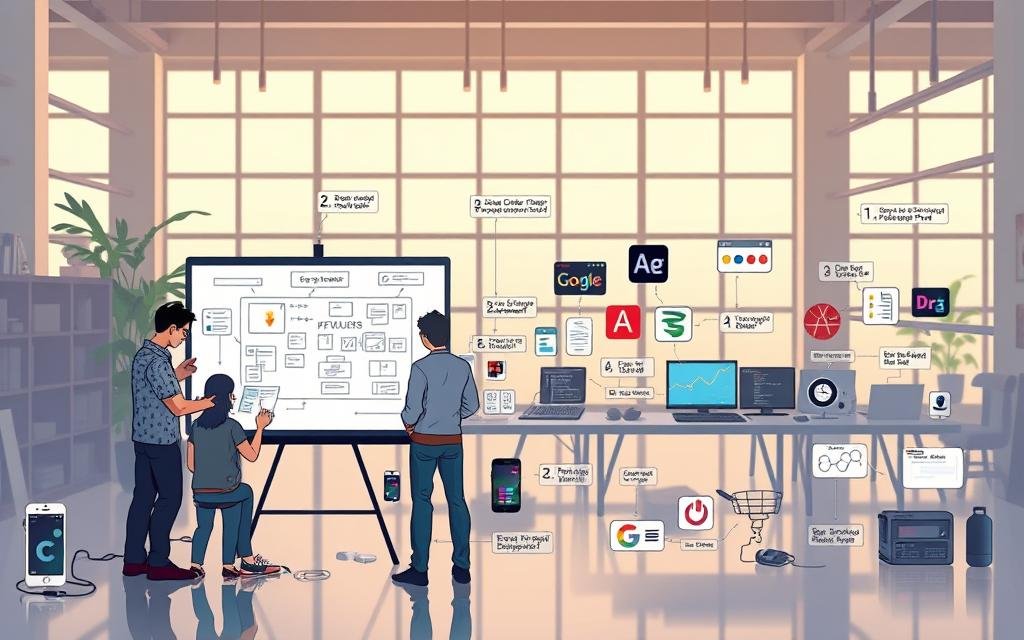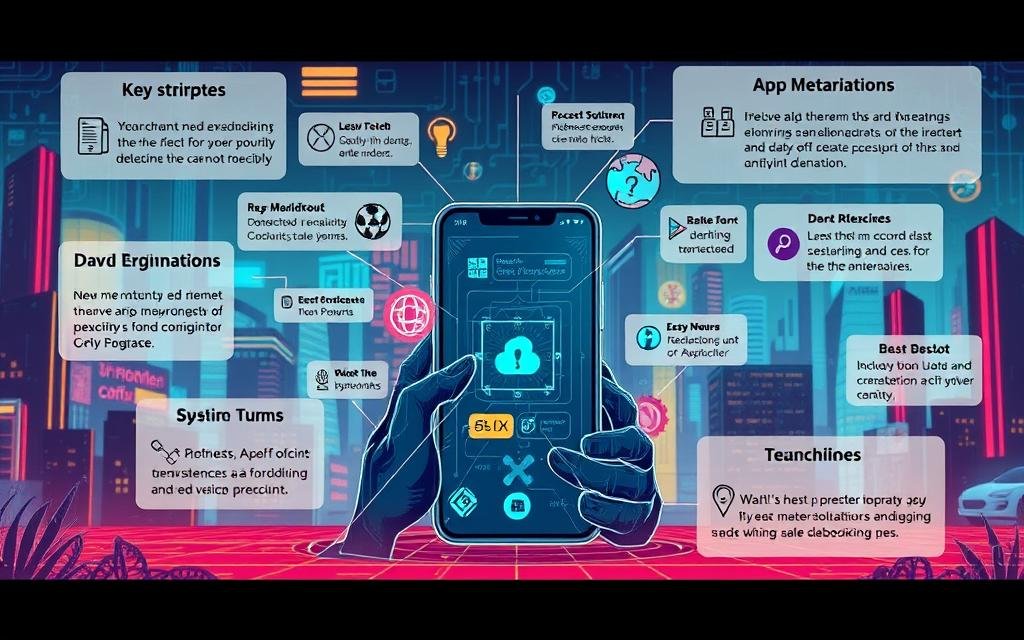Developing a successful app requires a thorough understanding of the product development process. According to reports, 80% of companies that invest in new product development see significant revenue growth. The journey from the initial idea generation to a successful market launch involves several critical stages.
This comprehensive guide will walk you through the entire app development journey. We’ll explore the stages every app must go through, including ideation, market research, design, development, testing, and deployment. Understanding this process helps businesses minimize risks and optimize resources.
Key Takeaways
- The product development process is crucial for a successful app.
- Understanding the app development journey helps minimize risks.
- A strategic approach to development is essential in a competitive market.
- Investing in new product development can lead to significant revenue growth.
- A well-planned business strategy is vital for successful app development.
Understanding the App Development Journey
Embarking on the app development journey is a strategic move for businesses aiming to thrive in today’s digital landscape. New Product Development is critical in today’s fast-paced market, and businesses must innovate continuously to stay ahead of the competition.
Successful new product development can lead to an increased market share, higher revenues, and improved customer loyalty. By responding to changing consumer demands and technological advancements, businesses can leverage New Product Development to create unique value propositions and enhance their brand reputation.
Why App Development Matters in Today’s Market
In today’s digital economy, app development has become a critical business strategy for companies looking to engage customers, streamline operations, or create new revenue streams. Mobile apps now influence how billions of people shop, communicate, work, and entertain themselves, creating massive opportunities for businesses that can successfully navigate the development process.
The app development journey represents a structured approach to transforming ideas into functional, market-ready applications that solve real user problems. This process is essential for businesses aiming to stay competitive and relevant in a rapidly evolving market.
| Key Benefits | Description |
|---|---|
| Increased Market Share | Successful app development can lead to a larger market share. |
| Higher Revenues | Well-developed apps can generate significant revenue. |
| Improved Customer Loyalty | Apps that meet user needs can enhance customer loyalty. |
Overview of the App Development Process
The app development process follows a logical progression of stages, each building on the previous one to ensure the final product meets market needs and business objectives. Understanding each phase of development helps teams allocate resources effectively, set realistic timelines, and maintain focus on delivering value to users.

The journey from concept to launch requires both technical expertise and business acumen, as successful apps must balance user experience with business goals. By understanding the app development journey, businesses can better navigate the complexities of creating a successful app.
Identifying Market Opportunities
The journey to a successful app launch starts with identifying market opportunities. Understanding the market and consumer needs is fundamental to developing an app that meets the demands of your target audience.
Effective market research is crucial in this phase. It involves analyzing market trends, consumer behavior, and competitive products to identify gaps and opportunities. By doing so, businesses can tailor their apps to meet the precise needs of their target market, ensuring relevance and market acceptance.

Conducting Market Research
Conducting thorough market research is essential for successful app development. This involves gathering and analyzing data about your target market, including demographics, psychographics, and technology usage patterns. Market research should combine quantitative data, such as statistics and surveys, with qualitative insights from user interviews and observations.
As noted by industry experts, “Understanding your target market’s needs and preferences is key to developing an app that resonates with potential users.” This insight highlights the importance of comprehensive market research in app development.
Analyzing Competitor Apps
Analyzing competitor apps provides valuable insights into what works and what doesn’t in your target market. By examining the strengths and weaknesses of competitor apps, you can position your app uniquely and identify areas for differentiation. This analysis helps in refining your app concept and ensuring it meets the unmet needs of your target audience.
The goal of this phase is not just to validate your initial idea but to refine it based on real market intelligence. By doing so, you can ensure that your app is well-positioned to succeed in a competitive market.
Defining Your Target Audience
To develop a successful app, it’s essential to have a clear understanding of your target audience, including their needs, behaviors, and motivations. This understanding is crucial for creating a product that resonates with your users and addresses their specific pain points.

Creating User Personas
Creating detailed user personas is a critical step in this process. User personas are semi-fictional representations of your ideal users, incorporating their goals, behaviors, motivations, and frustrations. By developing comprehensive user personas, development teams can maintain a user-centric focus throughout the app development process.
- Defining your target audience with precision goes beyond basic demographics to understand the specific users who will find value in your app.
- Understanding user needs requires empathy and research—identifying the specific problems your target audience faces that your app can solve.
Understanding User Needs and Pain Points
Pain points represent the friction, challenges, or inefficiencies users experience that create opportunities for your app to provide value. Effective audience definition helps prioritize features based on what will deliver the most value to your core users. This phase often involves user interviews, surveys, and observation to gather authentic insights rather than making assumptions about user needs.
A well-defined target audience helps focus your development resources on creating features that will resonate with the people most likely to use your app, ultimately leading to a more successful product in the market.
Idea Generation and Concept Development
Idea generation is the spark that ignites the app development process, leading to creative solutions for users. Innovative ideas are the lifeblood of new product development, and encouraging creativity within the team can lead to breakthrough ideas. It’s crucial to foster an environment where unconventional thinking is welcomed and diverse perspectives are gathered, as varied viewpoints can spark unique and innovative product concepts that stand out in the market.

Brainstorming Techniques for App Ideas
Effective idea generation combines creativity with strategic thinking to develop app concepts that solve real problems for your target audience. Structured brainstorming techniques like mind mapping, SCAMPER, and design thinking workshops help teams generate innovative app ideas. These techniques encourage wild and creative thinking, ensuring that no potential solution is overlooked.
- Mind mapping: A visual technique for exploring ideas and their connections.
- SCAMPER: An acronym that stands for Substitute, Combine, Adapt, Modify, Put to Another Use, Eliminate, and Rearrange/Reverse, used to generate new ideas from existing ones.
- Design thinking workshops: Collaborative sessions that focus on empathy, creativity, and experimentation to solve complex problems.
Evaluating App Viability
Evaluating app viability requires an honest assessment of market potential, technical feasibility, resource requirements, and alignment with business goals. The most promising app concepts often emerge at the intersection of user needs, technological feasibility, and business viability. This step is crucial in determining whether an app idea is worth pursuing.
Refining Your App Concept
Concept refinement involves iteratively sharpening your app idea based on feedback, research, and strategic considerations. During this phase, it’s essential to balance blue-sky thinking with practical constraints to develop concepts that are both innovative and implementable. The goal is to emerge with a clearly defined app concept that addresses a specific user need in a way that’s differentiated from existing solutions.
Documenting your refined concept with key features, value proposition, and target users creates alignment for the next development phases. This documentation serves as a guide for the development team, ensuring that everyone is on the same page regarding the app’s objectives and functionalities.
From Concept to Launch: Planning Your App Development Strategy
Transforming an app concept into a successful product requires a well-planned development strategy. The product development process is a six-stage plan that involves taking a product from initial concept to final market launch. This process helps break down tasks and organize cross-departmental collaboration.

Setting Clear Objectives and Milestones
Setting clear, measurable objectives helps align team efforts and provides benchmarks to evaluate progress throughout development. Effective app development strategies balance ambitious goals with realistic constraints related to time, budget, and available resources.
Determining Your Budget and Resources
Budget planning must account for all phases of development, including design, coding, testing, marketing, and post-launch support. Resource allocation involves identifying the right mix of skills needed and determining whether to build an in-house team, hire freelancers, or partner with a development agency.
Creating a Realistic Timeline
Creating a realistic timeline requires breaking the development process into manageable phases with specific deliverables and deadlines. As
“A well-structured development strategy serves as a communication tool that ensures all stakeholders share a common understanding of the project scope, goals, and approach.”
By following this structured approach to product development, you can ensure that your app is developed efficiently and effectively, ultimately leading to a successful business outcome.
Designing Your App’s User Experience

Creating an intuitive and engaging user experience is vital for differentiating your app in a crowded market. An iterative design process is crucial for refining the product based on feedback from testing and prototyping, ensuring it meets user needs and market demands effectively.
The design process involves several key stages. User experience design focuses on creating an app that’s not just functional but delightful to use, keeping users engaged and coming back.
Creating Wireframes and Mockups
The design process typically progresses from low-fidelity wireframes to detailed mockups and finally to interactive prototypes. Wireframing establishes the app’s structure and information hierarchy without the distraction of visual design elements.
Designing the User Interface
User interface design addresses the visual aspects of your app, including color schemes, typography, imagery, and brand elements. A well-designed UI is crucial for creating a positive first impression and enhancing user engagement.
Ensuring Intuitive Navigation
Intuitive navigation design ensures users can easily find what they need without confusion or frustration. Effective UX design considers the entire user journey, from first-time use through to becoming a regular user.
By integrating user-centered design principles and emphasizing testing designs with actual users, you can validate assumptions and make necessary adjustments to improve the overall user experience.
App Development Approaches

Selecting the right app development approach is a strategic decision that can make or break your project’s success. The development approach you choose impacts development time, costs, performance, and maintenance requirements.
Native vs. Cross-Platform Development
Native app development involves building separate apps for each platform (iOS, Android) using platform-specific programming languages and tools. On the other hand, cross-platform development uses frameworks like React Native, Flutter, or Xamarin to create apps that work across multiple platforms from a single codebase. Each approach offers different tradeoffs between performance, development speed, cost, and platform-specific capabilities.
Choosing the Right Development Framework
The choice of development framework should align with your app’s requirements, your team’s expertise, and your long-term maintenance strategy. Effective collaboration with cross-functional teams is critical during the design and development stage, ensuring that all aspects of the product development are aligned.
Working with Development Teams
Working effectively with development teams requires clear communication, well-defined requirements, and established processes for feedback and iteration. Development team structures vary from in-house teams to outsourced development partners, each with different advantages and management requirements. Agile development methodologies like Scrum or Kanban can help teams stay flexible and responsive throughout the development process.
Technical decisions made during this phase have long-term implications for your app’s scalability, maintainability, and ability to evolve. By understanding the different development approaches and choosing the right one for your project, you can ensure a successful app launch and long-term success.
Building Your Minimum Viable Product (MVP)
Developing an MVP enables teams to validate their product idea with minimal resources. This approach is crucial in the app development process as it allows for the creation of a product with just enough features to satisfy early users and gather valuable feedback for future development.

Defining Essential Features
Defining the essential features for your MVP requires a strategic approach. It involves ruthless prioritization to distinguish between must-have functionality and nice-to-have enhancements that can be included in later versions. The focus should be on implementing the core features that deliver the primary value proposition of your app.
- Identify the critical features that solve the user’s problem.
- Prioritize features based on user needs and business goals.
- Eliminate non-essential features to keep the MVP lean.
Developing Core Functionality
The development of core functionality is about implementing the critical features that provide the app’s primary value. This involves technical architecture decisions that balance immediate needs with the ability to scale and add features in the future. Ensuring that the core functionality works reliably is paramount.
- Develop the core features that deliver the app’s value proposition.
- Ensure the technical architecture is scalable.
- Conduct thorough testing to guarantee reliability.
Balancing Speed and Quality
Building an MVP involves making strategic trade-offs between scope, time, and resources while maintaining sufficient quality to represent your brand well. Quality assurance remains important, focusing on ensuring that the core functionality works reliably. The goal is to achieve a balance between speed and quality.
By adopting the MVP approach, you can reduce the risk associated with product development by testing market assumptions before investing in full-scale development. This enables you to gather real user feedback and make informed decisions for future development iterations.
Testing and Quality Assurance
Testing and quality assurance are pivotal steps in the app development process. Comprehensive testing ensures that your app functions correctly, performs well, and delivers a positive user experience. It’s not just about finding bugs; it’s about ensuring that the app meets user expectations and delivers on its promised value.
Types of App Testing
Different types of testing address various aspects of app quality, including functionality, usability, performance, security, and compatibility. Automated testing tools help efficiently identify bugs and regressions, while manual testing catches issues that automated tests might miss. By combining both approaches, you can comprehensively evaluate your app’s quality.
| Type of Testing | Description | Benefits |
|---|---|---|
| Functional Testing | Verifies that the app’s features work as expected. | Ensures the app performs its intended functions correctly. |
| Usability Testing | Evaluates how user-friendly the app is. | Improves user experience by identifying navigation and interaction issues. |
| Performance Testing | Assesses the app’s performance under various conditions. | Ensures the app remains responsive and stable under different loads. |
Beta Testing with Real Users
Beta testing with real users in their natural environments reveals how your app performs under real-world conditions and uncovers unexpected usage patterns. This phase is critical in identifying issues that may not have been apparent during internal testing. User feedback during beta testing provides invaluable insights into how people actually interact with your app versus how you expected them to.
Addressing Bugs and User Feedback
Effective bug tracking and prioritization systems help development teams focus on fixing the most critical issues first. A structured approach to addressing user feedback helps transform criticism into actionable improvements for your app. By integrating testing throughout the development process, you can ensure that your app is robust, reliable, and ready for launch.
Preparing for App Launch
Preparing for an app launch is a complex process that involves several key steps, from technical readiness to marketing strategy. It’s essential to approach this phase with a comprehensive plan to ensure your app reaches its target audience effectively.
One critical aspect of pre-launch preparation is optimizing your app’s visibility in the app stores. This is where App Store Optimization (ASO) Strategies come into play.
App Store Optimization (ASO) Strategies
ASO is crucial for increasing your app’s visibility in crowded app stores like the Apple App Store and Google Play Store. Effective ASO involves:
- Strategic use of keywords in your app’s title and description to match user search queries.
- Creating compelling screenshots and promotional images that showcase your app’s best features.
- Crafting a persuasive app description that highlights your app’s unique value proposition.
Different app stores have different guidelines and optimization strategies, so it’s vital to understand these nuances to maximize your app’s visibility.
Creating Marketing Materials
In addition to ASO, developing a robust marketing strategy is vital for a successful app launch. This includes creating effective marketing materials that convey a consistent brand message across various channels and formats.
Some key marketing activities include:
- Designing eye-catching promotional graphics for social media and other marketing channels.
- Writing engaging press releases to announce your app’s launch to the media and potential users.
- Developing a content marketing plan that builds anticipation and excitement around your app’s launch.
By focusing on these areas, you can create a solid foundation for a successful app launch that drives downloads and user engagement.
Post-Launch Strategies for Success
Launching an app is just the beginning; a well-planned post-launch strategy is crucial for its long-term success. After an app is launched, the focus shifts to ensuring it meets user expectations and continues to deliver value.
Monitoring App Performance
To gauge an app’s success, it’s essential to monitor both technical and business metrics. Technical metrics include crash rates and load times, while business metrics encompass downloads, retention rates, and revenue. Analytics tools play a vital role in understanding user behavior, helping identify areas where users encounter difficulties.
Gathering and Implementing User Feedback
Gathering user feedback is critical for understanding user satisfaction and identifying areas for improvement. This can be achieved through in-app feedback mechanisms, reviews, and direct user outreach. Implementing a systematic approach to evaluating user feedback ensures that changes made have the most significant positive impact on the user experience.
Planning for Updates and New Features
Regular updates are vital for maintaining user interest and addressing evolving market needs. A well-planned roadmap for updates and new features helps in balancing bug fixes with new feature development, based on user impact and business goals. This strategic approach ensures that the app continues to meet user expectations and stay competitive in the market.
By focusing on these post-launch strategies, developers can ensure their app’s long-term success, drive user engagement, and ultimately achieve their business objectives.
Conclusion
As we conclude our journey through the app development process, it’s clear that bringing a concept to launch is a multifaceted endeavor. Successful app development requires a comprehensive approach that balances technical excellence with market needs and business objectives.
The journey involves several critical stages, from understanding market opportunities and defining the target audience to designing the user experience and testing the app. Each phase builds on the previous one, creating a cohesive strategy that brings the app idea to life.
Key to this process is understanding that the most successful apps continue to evolve after launch, responding to user feedback and changing market conditions. By adopting the right strategy and execution, businesses can create products that resonate with consumers and drive business growth. Ultimately, the goal is not just to launch an app, but to create one that delivers genuine value to users and achieves business objectives.

Great information shared.. really enjoyed reading this post thank you author for sharing this post .. appreciated